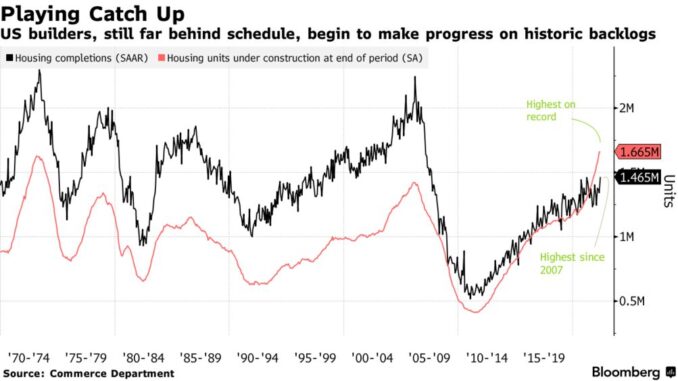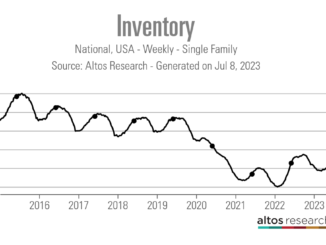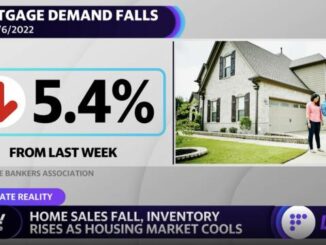
As existing home inventory continues to fall, builder confidence is on the rise, according to the National Association of Home Builders (NAHB)/Wells Fargo Housing Market Index (HMI) report, released Monday.
In April, home builder confidence in the market for newly build single-family homes rose to an index value of 45, an uptick of one point from the March reading. This is the fourth straight month of increases after a year of decreases.
The NAHB/HMI report is based on a monthly survey of NAHB members, in which homebuilders are asked to rate both current market conditions for the sale of new homes and expected conditions for the next six months, as well as traffic of prospective buyers of new homes. Scores for each component of the homebuilder confidence survey are then used to calculate an index, with any number greater than 50 indicating that more homebuilders view conditions as favorable than not.
“For the fourth straight month, builder confidence has increased due to a lack of resale inventory despite elevated interest rates,” Alicia Huey, the NAHB chairman, said in a statement. “Builders note that additional declines in mortgage rates, to below 6%, will price-in further demand for housing. Nonetheless, the industry continues to be plagued by building material issues, including lack of access to electrical transformer equipment.”
With sales back on the rise, the share of homebuilders reducing home prices has continued to decrease, dropping from 31% in March to 30% in April. The average price reduction was 6%, the same as a month prior, but down from the 8% price cuts reported in December.
Despite this, the share of builders using incentives to bolster sales has edged up to 59%, compared to 57% in February. However, this is still lower than the 62% reported in December.
“Currently, one-third of housing inventory is new construction, compared to historical norms of a little more than 10%,” Robert Dietz, the NAHB’s chief economist, said in a statement. “More buyers looking at new homes, along with the use of sales incentives, have supported new home sales since the start of 2023.”
Three other indices monitored by the NAHB had mixed results in April. The gauge measuring current sales conditions rose to 51, up two points month over month. The component analyzing sales expectations for the next six months rose six points to a reading of 50. This marks the first time since June 2022 that both of these components have risen to the 50+ range. Compared to a month prior, the gauge measuring traffic of prospective buyers remained unchanged at a reading of 31. This is the first time the traffic component failed to improve in 2023.
Regionally, the three-month moving averages for HMI rose in all four regions, with the West gaining four points to a reading of 38, the South increasing four points to 49, the Northeast adding four points for a reading of 46, and the Midwest rising two points to a reading of 37.
Another survey, the BTIG/HomeSphere State of the Industry Report, also reported an improvement in homebuilder outlook.
According to the survey, 40% of builders saw a yearly decrease in sales last month, down from 51% in February. Despite the yearly decrease in sales, builders again reported an improvement in performance relative to expectations, with 38% of respondents reporting that sales were better than expected, and 18% reporting that sales were worse than expected. These metrics improved from 27% and 27%, respectively, in February.
The BTIG/HomeSphere study is an electronic survey of approximately 75-125 small- to mid-sized homebuilders that sell, on average, 50-100 homes per year throughout the nation. In March, the survey had 119 respondents.
Like the builder confidence survey, the BTIG survey also reported mixed pricing activity. Of the 119 survey respondents, 21% of builders reported raising either some, most or all base prices in March compared to 27% last month, while 22% of builders lowered most, all or some base prices compared to 30% a month ago.
“New home demand momentum has continued to accelerate throughout the spring season, though pricing remains varied,” Carl Reichardt, a BTIG analyst, said in a statement.
The March survey included two special questions about compression of potential credit availability from regional banks, with nearly half of builders reporting that “some” or “many” customers have directly expressed concerns about recent regional banking headline events. In addition, 33% of builder expect to experience or have already experienced AD&C loan tightening from regional banking partners.
“And while AD&C loan conditions are tight, there is not significant evidence thus far that pressure on the regional bank system has made this lending environment for builders and land developers worse,” Dietz said.



